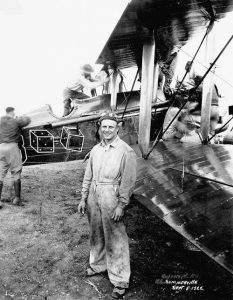By Marty Maisel
The Early Years

Young Jimmy Doolittle and his Mother, Nome, Alaska, circa 1904. (Image is in the public domain, National Air and Space Museum, Smithsonian Institution, SI-2002-995)
In 1910 Jimmy’s Manual Arts High School class attended the Los Angeles International Air Meet at Dominguez Field (present day Carson, CA). That event was the first major airshow in the United States and it left Doolittle with a fascination for aviation. While in high school he continued to hone his boxing skills and won the West Coast High School Amateur Championship in 1912.
After graduating from high school in 1914 he went to Alaska to reunite with his father, but returned to California the following year where he was admitted to the University of California School of Mines. During his time at the School of Mines, Doolittle continued to box and became the middleweight champion, even though he was only a lightweight boxer.
Army Aviator
In October 1917, six months after America entered the Great War, Doolittle took a leave of absence from his studies to enlist in the U.S. Army Signal Corps Reserve as a flying cadet. His aviation ground school training was conducted on the campus of the University of California and flight training was performed at Rockwell Field near Coronado, California. On March 11, 1918 Jimmy Doolittle received his Reserve Military Aviator rating and was commissioned a second lieutenant in the Signal Officers Reserve Corps of the U.S. Army.
Although he requested to be transferred to the European theater to contribute to the war effort as a fighter pilot, Doolittle remained in the United States as a flight and gunnery instructor. His assignments took him to Camp John Dick, Texas; Wright Field, Ohio; Gerstner Field, Louisiana; Rockwell Field, California; Kelly Field, Texas; and Eagle Pass, Texas. While he did not get to fly in combat prior to the Armistice, he qualified for retention after the war and was promoted to second lieutenant in the regular Army in July 1920.
In May 1921 Doolittle was assigned to Langley Field, Virginia as an Engineering Officer in support of General Billy Mitchell’s Naval ship bombing tests and flew some bombing missions during the 1921 Army/Navy War Games exercise.

Lt. Jimmy Doolittle at a refueling stop during his September 5, 1922 transcontinental flight. (Image is in the public domain)
About a year later, Doolittle flew a de Havilland DH-4 across the U.S. in 21 hours 19 minutes to demonstrate General Mitchell’s claim of air mobility and reliability. That was Jimmy Doolittle’s first record flight and the U.S. Army awarded him the Distinguished Flying Cross (DFC) for that feat.
Scholar
Doolittle was then selected to attend the Air Service Mechanical School at Kelly Field and the Air Service Engineering School at McCook Field, Ohio. In 1922 he completed his undergraduate work that was interrupted when he joined the Army and received a Bachelor of Arts degree from the University of California.
After serving briefly as a test pilot at McCook Field, the Army gave Jimmy Doolittle the opportunity to further his formal education at the Massachusetts Institute of Technology. For his master’s thesis he conducted aircraft acceleration tests at McCook Field in March 1924 and he received his Master of Science degree in Aeronautics from MIT in June of that year. His Master’s thesis led to his second Distinguished Flying Cross.
Since the Army had given him two years to get the Master of Science degree and he had accomplished that in just one year, he immediately started working on his Doctorate degree, which he received in June 1925. His doctoral dissertation “Wind Velocity Gradient and Its Effect on Flying Characteristics” determined that a pilot needs visual aids or instruments to know the direction in which the airplane is flying – challenging the long-held belief that good pilots can fly and navigate by “the seat of their pants.” Jimmy Doolittle’s Doctor of Science degree in aeronautical engineering was the first ever issued in the United States.
